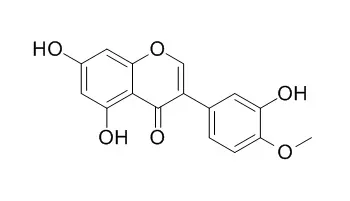| Kinase Assay: |
| Chem Biol Interact. 2016 Nov 25;259(Pt B):295-300. | | Flavonoids induce the expression of acetylcholinesterase in cultured osteoblasts.[Pubmed: 27019979] | Flavonoids, a group of natural compounds mainly derived from plants, are known to possess osteogenic effects in bone cells.
METHODS AND RESULTS:
Here, we aimed to test if flavonoid could induce a cholinergic enzyme, acetylcholinesterase (AChE), as well as bone differentiation. In cultured rat osteoblasts, twenty flavonoids, deriving from Chinese herbs and having known induction of alkaline phosphatase (ALP1) expression, were tested for its induction activity on AChE expression. Eleven flavonoids showed the induction, and five of them had robust activation of AChE expression, including baicalin, calycosin, genistin, hyperin and Pratensein: the induction of AChE included the levels of mRNA, protein and enzymatic activity. Moreover, the flavonoid-induced AChE expression in cultured osteoblast was in proline-rich membrane anchor (PRiMA)-linked tetrameric globular form (G4) only. In parallel, the expression of PRiMA was also induced by the application of flavonoids. The flavonoid-induced AChE in the cultures was not affected by estrogen receptor blocker, ICI 182,780.
CONCLUSIONS:
Taken together, the induction of PRiMA-linked AChE in osteoblast should be independent to classical estrogen signaling pathway. | | Biol Pharm Bull. 2009 Jul;32(7):1289-94. | | Characterization of the isoflavone pratensein as a novel transcriptional up-regulator of scavenger receptor class B type I in HepG2 cells.[Pubmed: 19571401] | Scavenger receptor class B type I (SR-BI), as well as its human homologue CLA-1, plays an important role in reverse cholesterol transport (RCT) as high density lipoprotein (HDL) receptor.
METHODS AND RESULTS:
Using a previously developed cell-based screening model for CLA-1 up-regulators, Pratensein, was shown to present activity in elevating CLA-1 transcriptional level. In this study, three other isoflavones including formononetin, genistein and daidzein were also shown to up-regulate CLA-1 transcriptional activity in the cell-based reporter assay. The effects of Pratensein on up-regulating CLA-1 expression were demonstrated at both mRNA and protein levels, and validated by its increasing of 1,1'-dioctadecyl-3,3,3',3'-tetramethylindocarbocyanine perchlorate-labeled (DiI)-HDL uptake in HepG2 cells. Furthermore, the cis-elements responsible for the Pratensein up-regulatory effects were mapped to the -1055/-182 bp fragment of CLA-1 promoter in HepG2 cells.
CONCLUSIONS:
These findings might provide a new molecular mechanism by which isoflavones potentially prevent atherosclerosis. |
|






 Cell. 2018 Jan 11;172(1-2):249-261.e12. doi: 10.1016/j.cell.2017.12.019.IF=36.216(2019)
Cell. 2018 Jan 11;172(1-2):249-261.e12. doi: 10.1016/j.cell.2017.12.019.IF=36.216(2019) Cell Metab. 2020 Mar 3;31(3):534-548.e5. doi: 10.1016/j.cmet.2020.01.002.IF=22.415(2019)
Cell Metab. 2020 Mar 3;31(3):534-548.e5. doi: 10.1016/j.cmet.2020.01.002.IF=22.415(2019) Mol Cell. 2017 Nov 16;68(4):673-685.e6. doi: 10.1016/j.molcel.2017.10.022.IF=14.548(2019)
Mol Cell. 2017 Nov 16;68(4):673-685.e6. doi: 10.1016/j.molcel.2017.10.022.IF=14.548(2019)